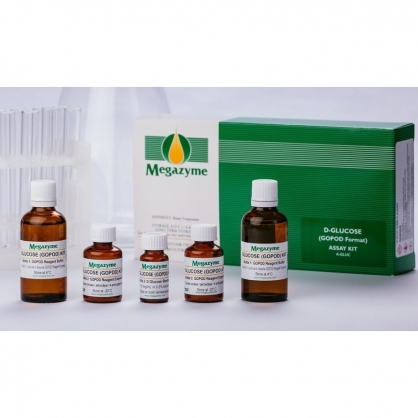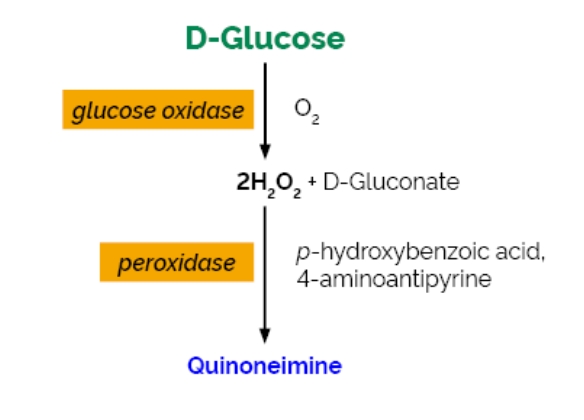- 試驗條件(ASSAY CONDITIONS)
Wavelength: 510 nm
Cuvette: 1 cm
Temperature: 40-50˚C
Final volume: 3.1 mL
Sample solution: 4-100 μg of glucose per cuvette (in 0.1 mL sample volume)
Read against: Reagent Blank

- 試驗流程ASSAY PROCEDURE
NOTE: Samples containing high amounts of protein or fats may cause interference in target analyte determination and require sample clarification prior to analysis using Carrez Clarification reagents. These reagents are available to purchase separately from Neogen in the Carrez Clarification Kit (K-CARREZ). The K-CARREZ reagents should be diluted prior to use as described on page 2 of the K-CARREZ assay protocol and the assay procedure for clarification followed as described on page 3. The clarified sample solution prepared using the K-CARREZ assay kit can then be analysed for D-glucose content as described in the assay procedure for liquid samples below.
液體樣品Liquid samples (e.g. Filtered Fruit Juice):
1. Clear colourless or slightly coloured solutions can be used directly in the assay (after dilution).
2. Samples should be diluted sufficiently in distilled water, to yield a D-glucose concentration of approx. 0.04-1 g/L D-glucose. (NOTE: It is recommended that the absorbance of the sample does not exceed that obtained for the Dglucose control sample. If the sample absorbance exceeds the control dilute the sample further to achieve a suitable absorbance.)
3. Add 0.1 mL of appropriately diluted liquid sample directly to the bottom of two 16 x 100 mm glass test tubes.
4. Prepare the reagent blank solutions by adding 0.1 mL of distilled water directly to the bottom of two 16 x 100 mm glass test tubes.
5. Prepare the D-glucose standards by adding 0.1 mL of Bottle 3 (D-glucose standard solution), directly to the bottom of 16 x 100 mm glass test tubes in quadruplicate.
6. Add 3.0 mL of GOPOD Reagent to all tubes and incubate these at 40-50˚C for 20 min.
7. Measure all absorbances at 510 nm against the reagent blank (i.e., zero the spectrophotometer against the reagent blank)
固體樣品Solid samples (e.g. Cereals or flours):
1. For solid samples grind the sample to pass a 0.5 mm screen, ensuring the sample is homogeneous. NOTE: The weights and volumes used in this procedure are provided as a guide only and may need to be altered depending on the sample being tested.
2. Weigh out a representative sample weight (e.g., 1 g) and add to a 100 mL volumetric flask and make to the mark (i.e. 100 mL) with distilled water. Stir vigorously until the sample is fully dispersed or dissolved.
3. Filter and use the clear solution, diluted further (if required) for the assay. Samples should be diluted to yield a D-glucose concentration of approx. 0.041 g/L D-glucose. (NOTE: It is recommended that the absorbance of the sample does not exceed that obtained for the D-glucose control sample. If the sample absorbance exceeds the control dilute the sample further to achieve a suitable absorbance.)
4. Add 0.1 mL of the obtained and appropriately diluted clear solution directly to the bottom of two 16 x 100 mm glass test tubes.
5. Prepare the reagent blank solutions by adding 0.1 mL of distilled water directly to the bottom of two 16 x 100 mm glass test tubes.
6. Prepare the D-glucose standards by adding 0.1 mL of Bottle 3 (D-glucose standard solution), directly to the bottom of 16 x 100 mm glass test tubes in quadruplicate.
7. Add 3.0 mL of GOPOD Reagent to all tubes and incubate these at 40-50˚C for 20 min.
8. Measure all absorbances at 510 nm against the reagent blank (i.e., zero the spectrophotometer against the reagent blank).
商品特色
商品規格
- 商品規格(660個檢測反應)
Bottle 1: (x 2)
GOPOD Reagent Buffer. Buffer (50 mL, pH 7.4), p-hydroxybenzoic acid and sodium azide (0.09% w/v).
Store at 4°C. See individual label for expiry date.
Bottle 2: (x 2)
GOPOD Reagent Enzymes. Glucose oxidase plus peroxidase and 4-aminoantipyrine. Freeze-dried powder.
Store below -10 °C. See individual label for expiry date.
Bottle 3:
D-Glucose standard solution (5 mL, 1.0 mg/mL) in 0.2% (w/v) benzoic acid.
Store sealed at room temperature. See individual label for expiry date.



